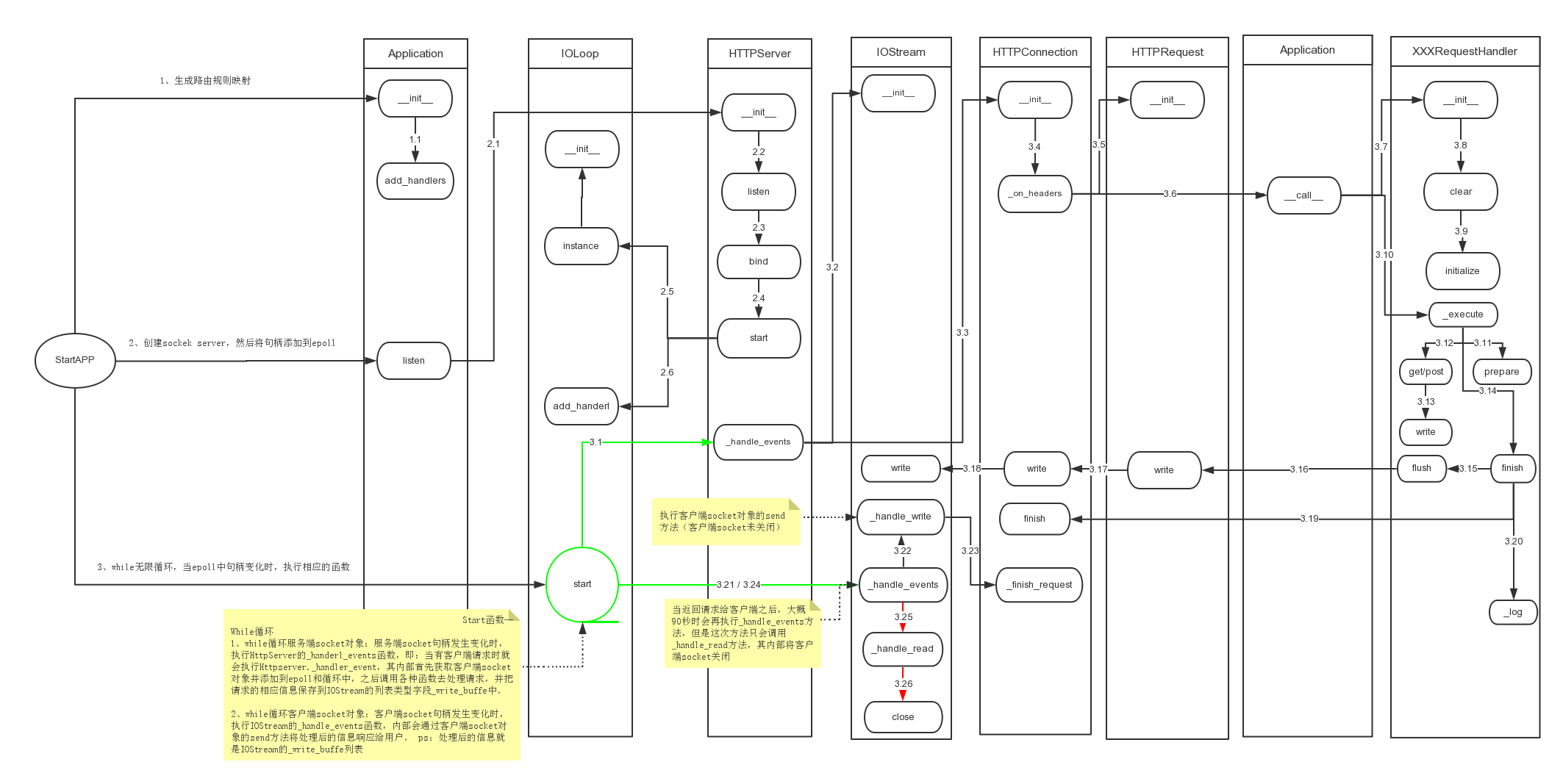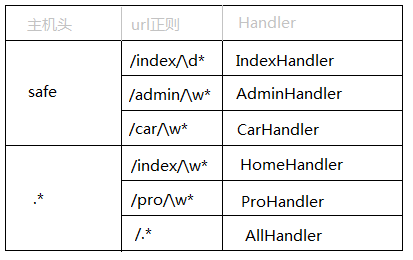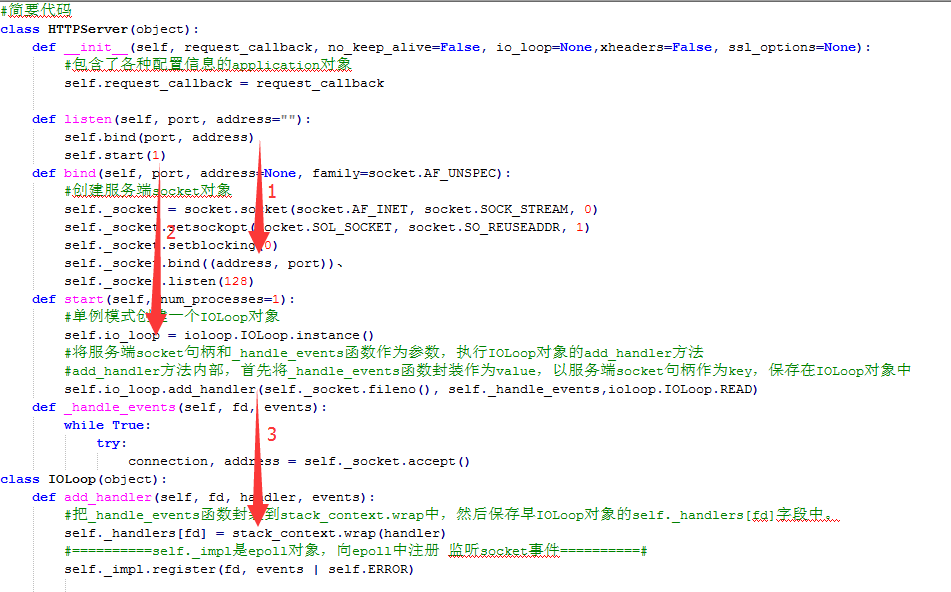上篇《白话tornado源码之一个脚本引发的血案》用上帝视角多整个框架做了一个概述,同时也看清了web框架的的本质,下面我们从tornado程序的起始来分析其源码。
概述

上图是tornado程序启动以及接收到客户端请求后的整个过程,对于整个过程可以分为两大部分:
- 启动程序阶段,又称为待请求阶段(上图1、2所有系列和3.0)
- 接收并处理客户端请求阶段(上图3系列)
简而言之:
1、在启动程序阶段,第一步,获取配置文件然后生成url映射(即:一个url对应一个XXRequestHandler,从而让XXRequestHandler来处理指定url发送的请求);第二步,创建服务器socket对象并添加到epoll中;第三步,创建无线循环去监听epoll。
2、在接收并处理请求阶段,第一步,接收客户端socket发送的请求(socket.accept);第二步,从请求中获取请求头信息,再然后根据请求头中的请求url去匹配某个XXRequestHandler;第三步,匹配成功的XXRequestHandler处理请求;第四步,将处理后的请求发送给客户端;第五步,关闭客户端socket。
本篇的内容主要剖析【启动程序阶段】,下面我们就来一步一步的剖析整个过程,在此阶段主要是有下面重点标注的三个方法来实现。
import tornado.ioloop import tornado.web class MainHandler(tornado.web.RequestHandler): def get(self): self.write("Hello, world") application = tornado.web.Application([ (r"/index", MainHandler), ]) if __name__ == "__main__": application.listen(8888) tornado.ioloop.IOLoop.instance().start()
一、application = tornado.web.Application([(xxx,xxx)])
执行Application类的构造函数,并传入一个列表类型的参数,这个列表里保存的是url规则和对应的处理类,即:当客户端的请求url可以配置这个规则时,那么该请求就交由对应的Handler去执行。
注意:Handler泛指继承自RequestHandler的所有类
Handlers泛指继承自RequestHandler的所有类的集合

class Application(object): def __init__(self, handlers=None, default_host="", transforms=None,wsgi=False, **settings): #设置响应的编码和返回方式,对应的http相应头:Content-Encoding和Transfer-Encoding #Content-Encoding:gzip 表示对数据进行压缩,然后再返回给用户,从而减少流量的传输。 #Transfer-Encoding:chunck 表示数据的传送方式通过一块一块的传输。 if transforms is None: self.transforms = [] if settings.get("gzip"): self.transforms.append(GZipContentEncoding) self.transforms.append(ChunkedTransferEncoding) else: self.transforms = transforms #将参数赋值为类的变量 self.handlers = [] self.named_handlers = {} self.default_host = default_host self.settings = settings #ui_modules和ui_methods用于在模版语言中扩展自定义输出 #这里将tornado内置的ui_modules和ui_methods添加到类的成员变量self.ui_modules和self.ui_methods中 self.ui_modules = {'linkify': _linkify, 'xsrf_form_html': _xsrf_form_html, 'Template': TemplateModule, } self.ui_methods = {} self._wsgi = wsgi #获取获取用户自定义的ui_modules和ui_methods,并将他们添加到之前创建的成员变量self.ui_modules和self.ui_methods中 self._load_ui_modules(settings.get("ui_modules", {})) self._load_ui_methods(settings.get("ui_methods", {})) #设置静态文件路径,设置方式则是通过正则表达式匹配url,让StaticFileHandler来处理匹配的url if self.settings.get("static_path"): #从settings中读取key为static_path的值,用于设置静态文件路径 path = self.settings["static_path"] #获取参数中传入的handlers,如果空则设置为空列表 handlers = list(handlers or []) #静态文件前缀,默认是/static/ static_url_prefix = settings.get("static_url_prefix","/static/") #在参数中传入的handlers前再添加三个映射: #【/static/.*】 --> StaticFileHandler #【/(favicon.ico)】 --> StaticFileHandler #【/(robots.txt)】 --> StaticFileHandler handlers = [ (re.escape(static_url_prefix) + r"(.*)", StaticFileHandler,dict(path=path)), (r"/(favicon.ico)", StaticFileHandler, dict(path=path)), (r"/(robots.txt)", StaticFileHandler, dict(path=path)), ] + handlers #执行本类的Application的add_handlers方法 #此时,handlers是一个列表,其中的每个元素都是一个对应关系,即:url正则表达式和处理匹配该正则的url的Handler if handlers: self.add_handlers(".*$", handlers) # Automatically reload modified modules #如果settings中设置了 debug 模式,那么就使用自动加载重启 if self.settings.get("debug") and not wsgi: import autoreload autoreload.start()

class Application(object): def add_handlers(self, host_pattern, host_handlers): #如果主机模型最后没有结尾符,那么就为他添加一个结尾符。 if not host_pattern.endswith("$"): host_pattern += "$" handlers = [] #对主机名先做一层路由映射,例如:http://www.wupeiqi.com 和 http://safe.wupeiqi.com #即:safe对应一组url映射,www对应一组url映射,那么当请求到来时,先根据它做第一层匹配,之后再继续进入内部匹配。 #对于第一层url映射来说,由于.*会匹配所有的url,所将 .* 的永远放在handlers列表的最后,不然 .* 就会截和了... #re.complie是编译正则表达式,以后请求来的时候只需要执行编译结果的match方法就可以去匹配了 if self.handlers and self.handlers[-1][0].pattern == '.*$': self.handlers.insert(-1, (re.compile(host_pattern), handlers)) else: self.handlers.append((re.compile(host_pattern), handlers)) #遍历我们设置的和构造函数中添加的【url->Handler】映射,将url和对应的Handler封装到URLSpec类中(构造函数中会对url进行编译) #并将所有的URLSpec对象添加到handlers列表中,而handlers列表和主机名模型组成一个元祖,添加到self.Handlers列表中。 for spec in host_handlers: if type(spec) is type(()): assert len(spec) in (2, 3) pattern = spec[0] handler = spec[1] if len(spec) == 3: kwargs = spec[2] else: kwargs = {} spec = URLSpec(pattern, handler, kwargs) handlers.append(spec) if spec.name: #未使用该功能,默认spec.name = None if spec.name in self.named_handlers: logging.warning("Multiple handlers named %s; replacing previous value",spec.name) self.named_handlers[spec.name] = spec

class URLSpec(object): def __init__(self, pattern, handler_class, kwargs={}, name=None): if not pattern.endswith('$'): pattern += '$' self.regex = re.compile(pattern) self.handler_class = handler_class self.kwargs = kwargs self.name = name self._path, self._group_count = self._find_groups()
上述代码主要完成了以下功能:加载配置信息和生成url映射,并且把所有的信息封装在一个application对象中。
加载的配置信息包括:
- 编码和返回方式信息
- 静态文件路径
- ui_modules(模版语言中使用,暂时忽略)
- ui_methods(模版语言中使用,暂时忽略)
- 是否debug模式运行
以上的所有配置信息,都可以在settings中配置,然后在创建Application对象时候,传入参数即可。如:application = tornado.web.Application([(r"/index", MainHandler),],**settings)
生成url映射:
- 将url和对应的Handler添加到对应的主机前缀中,如:safe.index.com、www.auto.com

封装数据:
将配置信息和url映射关系封装到Application对象中,信息分别保存在Application对象的以下字段中:
- self.transforms,保存着编码和返回方式信息
- self.settings,保存着配置信息
- self.ui_modules,保存着ui_modules信息
- self.ui_methods,保存这ui_methods信息
- self.handlers,保存着所有的主机名对应的Handlers,每个handlers则是url正则对应的Handler
二、application.listen(xxx)
第一步操作将配置和url映射等信息封装到了application对象中,而这第二步执行application对象的listen方法,该方法内部又把之前包含各种信息的application对象封装到了一个HttpServer对象中,然后继续调用HttpServer对象的liseten方法。
class Application(object): #创建服务端socket,并绑定IP和端口并添加相应设置,注:未开始通过while监听accept,等待客户端连接 def listen(self, port, address="", **kwargs): from tornado.httpserver import HTTPServer server = HTTPServer(self, **kwargs) server.listen(port, address)

详细代码:

class HTTPServer(object): def __init__(self, request_callback, no_keep_alive=False, io_loop=None,xheaders=False, ssl_options=None): #Application对象 self.request_callback = request_callback #是否长连接 self.no_keep_alive = no_keep_alive #IO循环 self.io_loop = io_loop self.xheaders = xheaders #Http和Http self.ssl_options = ssl_options self._socket = None self._started = False def listen(self, port, address=""): self.bind(port, address) self.start(1) def bind(self, port, address=None, family=socket.AF_UNSPEC): assert not self._socket #创建服务端socket对象,IPV4和TCP连接 self._socket = socket.socket(socket.AF_INET, socket.SOCK_STREAM, 0) flags = fcntl.fcntl(self._socket.fileno(), fcntl.F_GETFD) flags |= fcntl.FD_CLOEXEC fcntl.fcntl(self._socket.fileno(), fcntl.F_SETFD, flags) #配置socket对象 self._socket.setsockopt(socket.SOL_SOCKET, socket.SO_REUSEADDR, 1) self._socket.setblocking(0) #绑定IP和端口 self._socket.bind((address, port)) #最大阻塞数量 self._socket.listen(128) def start(self, num_processes=1): assert not self._started self._started = True if num_processes is None or num_processes <= 0: num_processes = _cpu_count() if num_processes > 1 and ioloop.IOLoop.initialized(): logging.error("Cannot run in multiple processes: IOLoop instance " "has already been initialized. You cannot call " "IOLoop.instance() before calling start()") num_processes = 1 #如果进程数大于1 if num_processes > 1: logging.info("Pre-forking %d server processes", num_processes) for i in range(num_processes): if os.fork() == 0: import random from binascii import hexlify try: # If available, use the same method as # random.py seed = long(hexlify(os.urandom(16)), 16) except NotImplementedError: # Include the pid to avoid initializing two # processes to the same value seed(int(time.time() * 1000) ^ os.getpid()) random.seed(seed) self.io_loop = ioloop.IOLoop.instance() self.io_loop.add_handler( self._socket.fileno(), self._handle_events, ioloop.IOLoop.READ) return os.waitpid(-1, 0) #进程数等于1,默认 else: if not self.io_loop: #设置成员变量self.io_loop为IOLoop的实例,注:IOLoop使用methodclass完成了一个单例模式 self.io_loop = ioloop.IOLoop.instance() #执行IOLoop的add_handler方法,将socket句柄、self._handle_events方法和IOLoop.READ当参数传入 self.io_loop.add_handler(self._socket.fileno(), self._handle_events, ioloop.IOLoop.READ) def _handle_events(self, fd, events): while True: try: #====important=====# connection, address = self._socket.accept() except socket.error, e: if e.args[0] in (errno.EWOULDBLOCK, errno.EAGAIN): return raise if self.ssl_options is not None: assert ssl, "Python 2.6+ and OpenSSL required for SSL" try: #====important=====# connection = ssl.wrap_socket(connection,server_side=True,do_handshake_on_connect=False,**self.ssl_options) except ssl.SSLError, err: if err.args[0] == ssl.SSL_ERROR_EOF: return connection.close() else: raise except socket.error, err: if err.args[0] == errno.ECONNABORTED: return connection.close() else: raise try: if self.ssl_options is not None: stream = iostream.SSLIOStream(connection, io_loop=self.io_loop) else: stream = iostream.IOStream(connection, io_loop=self.io_loop) #====important=====# HTTPConnection(stream, address, self.request_callback,self.no_keep_alive, self.xheaders) except: logging.error("Error in connection callback", exc_info=True)

class IOLoop(object): # Constants from the epoll module _EPOLLIN = 0x001 _EPOLLPRI = 0x002 _EPOLLOUT = 0x004 _EPOLLERR = 0x008 _EPOLLHUP = 0x010 _EPOLLRDHUP = 0x2000 _EPOLLONESHOT = (1 << 30) _EPOLLET = (1 << 31) # Our events map exactly to the epoll events NONE = 0 READ = _EPOLLIN WRITE = _EPOLLOUT ERROR = _EPOLLERR | _EPOLLHUP | _EPOLLRDHUP def __init__(self, impl=None): self._impl = impl or _poll() if hasattr(self._impl, 'fileno'): self._set_close_exec(self._impl.fileno()) self._handlers = {} self._events = {} self._callbacks = [] self._timeouts = [] self._running = False self._stopped = False self._blocking_signal_threshold = None # Create a pipe that we send bogus data to when we want to wake # the I/O loop when it is idle if os.name != 'nt': r, w = os.pipe() self._set_nonblocking(r) self._set_nonblocking(w) self._set_close_exec(r) self._set_close_exec(w) self._waker_reader = os.fdopen(r, "rb", 0) self._waker_writer = os.fdopen(w, "wb", 0) else: self._waker_reader = self._waker_writer = win32_support.Pipe() r = self._waker_writer.reader_fd self.add_handler(r, self._read_waker, self.READ) @classmethod def instance(cls): if not hasattr(cls, "_instance"): cls._instance = cls() return cls._instance def add_handler(self, fd, handler, events): """Registers the given handler to receive the given events for fd.""" self._handlers[fd] = stack_context.wrap(handler) self._impl.register(fd, events | self.ERROR)

def wrap(fn): '''Returns a callable object that will resore the current StackContext when executed. Use this whenever saving a callback to be executed later in a different execution context (either in a different thread or asynchronously in the same thread). ''' if fn is None: return None # functools.wraps doesn't appear to work on functools.partial objects #@functools.wraps(fn) def wrapped(callback, contexts, *args, **kwargs): # If we're moving down the stack, _state.contexts is a prefix # of contexts. For each element of contexts not in that prefix, # create a new StackContext object. # If we're moving up the stack (or to an entirely different stack), # _state.contexts will have elements not in contexts. Use # NullContext to clear the state and then recreate from contexts. if (len(_state.contexts) > len(contexts) or any(a[1] is not b[1] for a, b in itertools.izip(_state.contexts, contexts))): # contexts have been removed or changed, so start over new_contexts = ([NullContext()] + [cls(arg) for (cls,arg) in contexts]) else: new_contexts = [cls(arg) for (cls, arg) in contexts[len(_state.contexts):]] if len(new_contexts) > 1: with contextlib.nested(*new_contexts): callback(*args, **kwargs) elif new_contexts: with new_contexts[0]: callback(*args, **kwargs) else: callback(*args, **kwargs) if getattr(fn, 'stack_context_wrapped', False): return fn contexts = _state.contexts result = functools.partial(wrapped, fn, contexts) result.stack_context_wrapped = True return result
备注:stack_context.wrap其实就是对函数进行一下封装,即:函数在不同情况下上下文信息可能不同。
上述代码本质上就干了以下这么四件事:
- 把包含了各种配置信息的application对象封装到了HttpServer对象的request_callback字段中
- 创建了服务端socket对象
- 单例模式创建IOLoop对象,然后将socket对象句柄作为key,被封装了的函数_handle_events作为value,添加到IOLoop对象的_handlers字段中
- 向epoll中注册监听服务端socket对象的读可用事件
目前,我们只是看到上述代码大致干了这四件事,而其目的有什么?他们之间的联系又是什么呢?
答:现在不妨先来做一个猜想,待之后再在源码中确认验证是否正确!猜想:通过epoll监听服务端socket事件,一旦请求到达时,则执行3中被封装了的_handle_events函数,该函数又利用application中封装了的各种配置信息对客户端url来指定判定,然后指定对应的Handler处理该请求。
注意:使用epoll创建服务端socket

import socket, select EOL1 = b'/n/n' EOL2 = b'/n/r/n' response = b'HTTP/1.0 200 OK/r/nDate: Mon, 1 Jan 1996 01:01:01 GMT/r/n' response += b'Content-Type: text/plain/r/nContent-Length: 13/r/n/r/n' response += b'Hello, world!' serversocket = socket.socket(socket.AF_INET, socket.SOCK_STREAM) serversocket.setsockopt(socket.SOL_SOCKET, socket.SO_REUSEADDR, 1) serversocket.bind(('0.0.0.0', 8080)) serversocket.listen(1) serversocket.setblocking(0) epoll = select.epoll() epoll.register(serversocket.fileno(), select.EPOLLIN) try: connections = {}; requests = {}; responses = {} while True: events = epoll.poll(1) for fileno, event in events: if fileno == serversocket.fileno(): connection, address = serversocket.accept() connection.setblocking(0) epoll.register(connection.fileno(), select.EPOLLIN) connections[connection.fileno()] = connection requests[connection.fileno()] = b'' responses[connection.fileno()] = response elif event & select.EPOLLIN: requests[fileno] += connections[fileno].recv(1024) if EOL1 in requests[fileno] or EOL2 in requests[fileno]: epoll.modify(fileno, select.EPOLLOUT) print('-'*40 + '/n' + requests[fileno].decode()[:-2]) elif event & select.EPOLLOUT: byteswritten = connections[fileno].send(responses[fileno]) responses[fileno] = responses[fileno][byteswritten:] if len(responses[fileno]) == 0: epoll.modify(fileno, 0) connections[fileno].shutdown(socket.SHUT_RDWR) elif event & select.EPOLLHUP: epoll.unregister(fileno) connections[fileno].close() del connections[fileno] finally: epoll.unregister(serversocket.fileno()) epoll.close() serversocket.close()
上述,其实就是利用epoll对象的poll(timeout)方法去轮询已经注册在epoll中的socket句柄,当有读可用的信息时候,则返回包含当前句柄和Event Code的序列,然后在通过句柄对客户端的请求进行处理
三、tornado.ioloop.IOLoop.instance().start()
上一步中创建了socket对象并使得socket对象和epoll建立了关系,该步骤则就来执行epoll的epoll方法去轮询已经注册在epoll对象中的socket句柄,当有读可用信息时,则触发一些操作什么的....
class IOLoop(object):
def add_handler(self, fd, handler, events):
#HttpServer的Start方法中会调用该方法
self._handlers[fd] = stack_context.wrap(handler)
self._impl.register(fd, events | self.ERROR)
def start(self):
while True:
poll_timeout = 0.2
try:
#epoll中轮询
event_pairs = self._impl.poll(poll_timeout)
except Exception, e:
#省略其他
#如果有读可用信息,则把该socket对象句柄和Event Code序列添加到self._events中
self._events.update(event_pairs)
#遍历self._events,处理每个请求
while self._events:
fd, events = self._events.popitem()
try:
#以socket为句柄为key,取出self._handlers中的stack_context.wrap(handler),并执行
#stack_context.wrap(handler)包装了HTTPServer类的_handle_events函数的一个函数
#是在上一步中执行add_handler方法时候,添加到self._handlers中的数据。
self._handlers[fd](fd, events)
except:
#省略其他

class IOLoop(object): def start(self): """Starts the I/O loop. The loop will run until one of the I/O handlers calls stop(), which will make the loop stop after the current event iteration completes. """ if self._stopped: self._stopped = False return self._running = True while True: # Never use an infinite timeout here - it can stall epoll poll_timeout = 0.2 # Prevent IO event starvation by delaying new callbacks # to the next iteration of the event loop. callbacks = self._callbacks self._callbacks = [] for callback in callbacks: self._run_callback(callback) if self._callbacks: poll_timeout = 0.0 if self._timeouts: now = time.time() while self._timeouts and self._timeouts[0].deadline <= now: timeout = self._timeouts.pop(0) self._run_callback(timeout.callback) if self._timeouts: milliseconds = self._timeouts[0].deadline - now poll_timeout = min(milliseconds, poll_timeout) if not self._running: break if self._blocking_signal_threshold is not None: # clear alarm so it doesn't fire while poll is waiting for # events. signal.setitimer(signal.ITIMER_REAL, 0, 0) try: event_pairs = self._impl.poll(poll_timeout) except Exception, e: # Depending on python version and IOLoop implementation, # different exception types may be thrown and there are # two ways EINTR might be signaled: # * e.errno == errno.EINTR # * e.args is like (errno.EINTR, 'Interrupted system call') if (getattr(e, 'errno', None) == errno.EINTR or (isinstance(getattr(e, 'args', None), tuple) and len(e.args) == 2 and e.args[0] == errno.EINTR)): continue else: raise if self._blocking_signal_threshold is not None: signal.setitimer(signal.ITIMER_REAL, self._blocking_signal_threshold, 0) # Pop one fd at a time from the set of pending fds and run # its handler. Since that handler may perform actions on # other file descriptors, there may be reentrant calls to # this IOLoop that update self._events self._events.update(event_pairs) while self._events: fd, events = self._events.popitem() try: self._handlers[fd](fd, events) except (KeyboardInterrupt, SystemExit): raise except (OSError, IOError), e: if e.args[0] == errno.EPIPE: # Happens when the client closes the connection pass else: logging.error("Exception in I/O handler for fd %d", fd, exc_info=True) except: logging.error("Exception in I/O handler for fd %d", fd, exc_info=True) # reset the stopped flag so another start/stop pair can be issued self._stopped = False if self._blocking_signal_threshold is not None: signal.setitimer(signal.ITIMER_REAL, 0, 0)
对于上述代码,执行start方法后,程序就进入“死循环”,也就是会一直不停的轮询的去检查是否有请求到来,如果有请求到达,则执行封装了HttpServer类的_handle_events方法和相关上下文的stack_context.wrap(handler)(其实就是执行HttpServer类的_handle_events方法),详细见下篇博文,简要代码如下:
class HTTPServer(object): def _handle_events(self, fd, events): while True: try: connection, address = self._socket.accept() except socket.error, e: if e.args[0] in (errno.EWOULDBLOCK, errno.EAGAIN): return raise if self.ssl_options is not None: assert ssl, "Python 2.6+ and OpenSSL required for SSL" try: connection = ssl.wrap_socket(connection, server_side=True, do_handshake_on_connect=False, **self.ssl_options) except ssl.SSLError, err: if err.args[0] == ssl.SSL_ERROR_EOF: return connection.close() else: raise except socket.error, err: if err.args[0] == errno.ECONNABORTED: return connection.close() else: raise try: if self.ssl_options is not None: stream = iostream.SSLIOStream(connection, io_loop=self.io_loop) else: stream = iostream.IOStream(connection, io_loop=self.io_loop) HTTPConnection(stream, address, self.request_callback, self.no_keep_alive, self.xheaders) except: logging.error("Error in connection callback", exc_info=True)
结束
本篇博文介绍了“待请求阶段”的所作所为,简要来说其实就是三件事:其一、把setting中的各种配置以及url和Handler之间的映射关系封装到来application对象中(application对象又被封装到了HttpServer对象的request_callback字段中);其二、结合epoll创建服务端socket;其三、当请求到达时交由HttpServer类的_handle_events方法处理请求,即:处理请求的入口。对于处理请求的详细,请参见下篇博客(客官莫急,加班编写中...)
